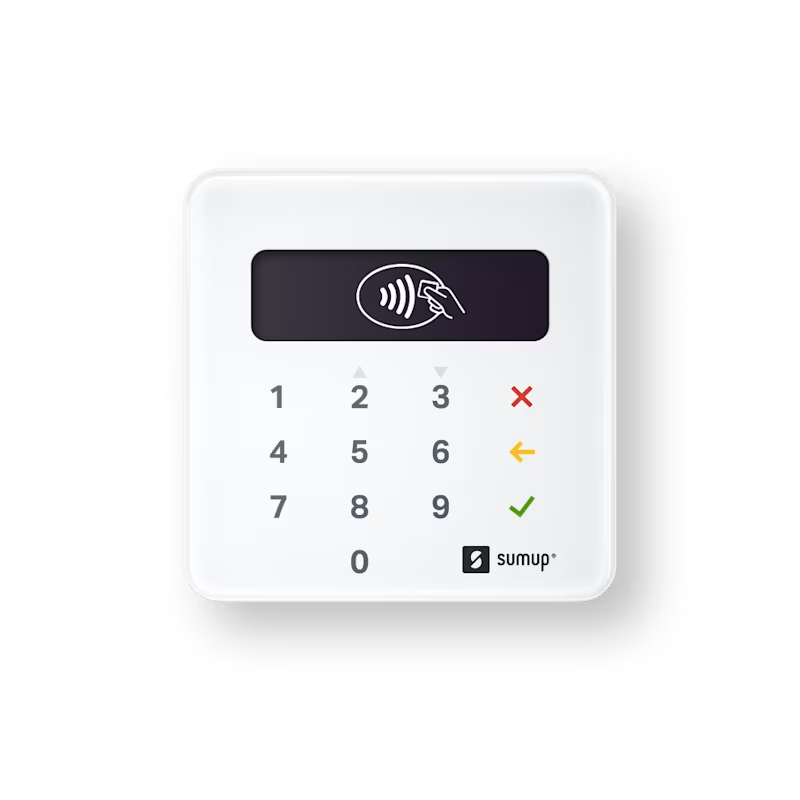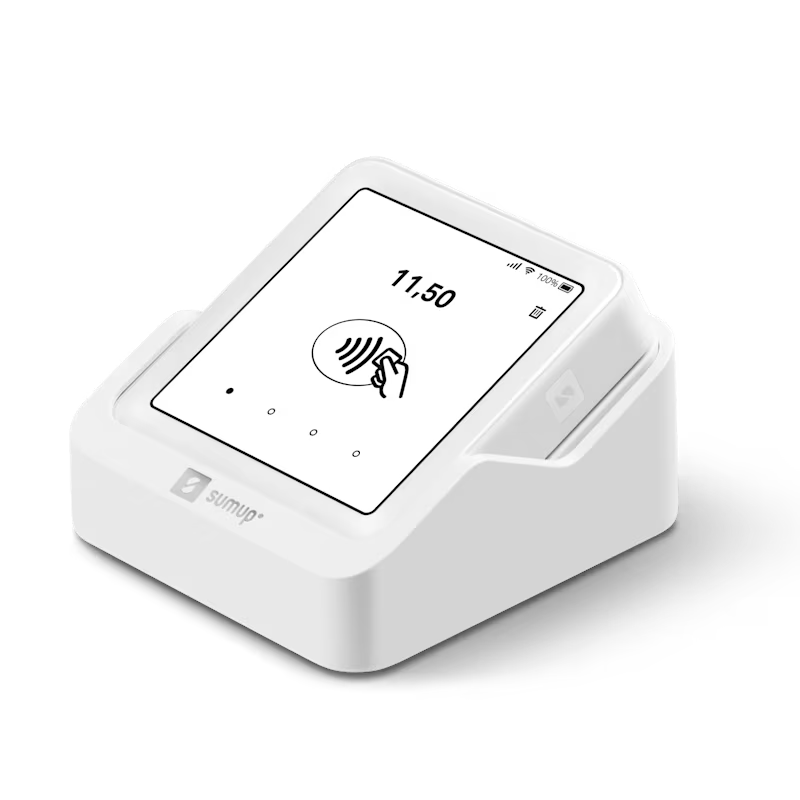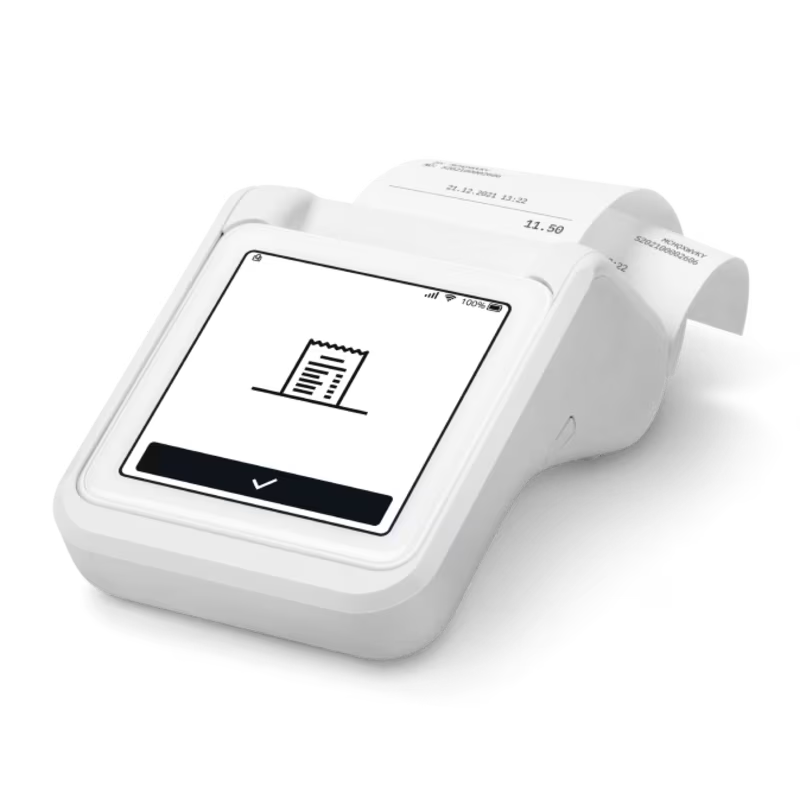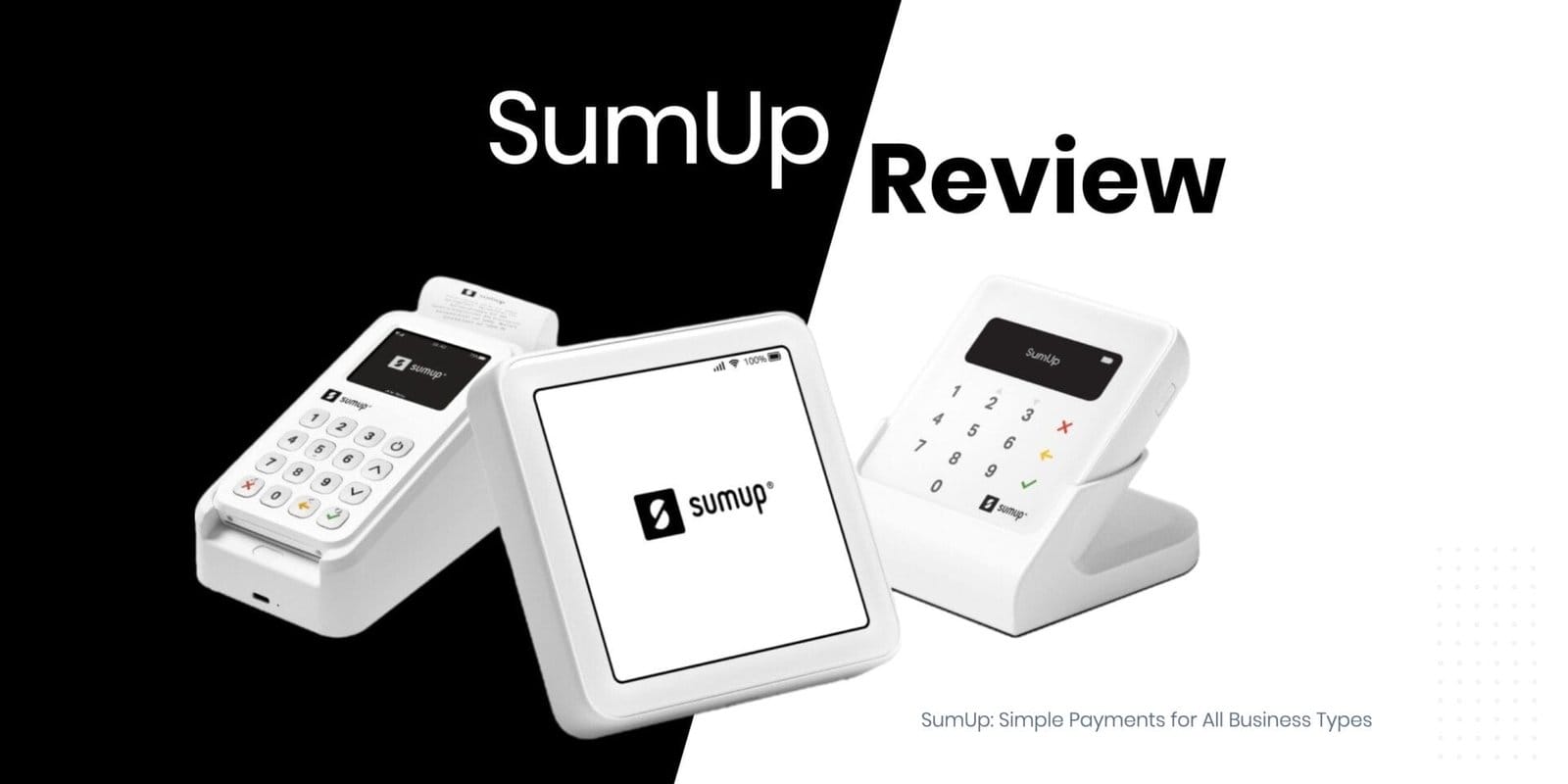What is a Card Reader?
A card reader is a portable electronic device that allows small businesses, self-employed professionals, and freelancers to accept credit and debit card payments from customers. These compact devices connect wirelessly to smartphones or tablets, or function as standalone units, enabling merchants to process transactions anywhere with an internet connection. Card readers have transformed how independent professionals and small businesses operate by providing an affordable alternative to traditional point-of-sale (POS) systems. They support various payment methods including chip and PIN, contactless cards, and digital wallets like Apple Pay and Google Pay. Modern card readers offer additional features beyond payment processing, such as inventory management, sales reporting, and customer relationship tools through companion apps.
Why Use a Card Reader?
Card readers provide significant benefits for businesses of all sizes. First, they expand payment options for customers who prefer not to carry cash, potentially increasing sales volume and average transaction size. Research consistently shows that consumers spend more when using cards compared to cash payments. Card readers also enhance professionalism and customer trust, as accepting card payments signals legitimacy and customer-focused service.
For mobile businesses and those operating in multiple locations, card readers offer unmatched flexibility. With battery-powered operation and wireless connectivity, merchants can process payments anywhere customers are located—at markets, during home service calls, or at events. This removes geographical limitations on business operations.
Card readers also improve financial management through digital transaction records, making accounting and tax preparation more efficient. Most card reader services provide detailed sales reports, helping business owners track performance and identify trends.
Additionally, card readers often integrate with broader business management systems, connecting payment processing with inventory tracking, customer databases, and marketing tools in one ecosystem. This integration streamlines operations and provides valuable business insights.
How Does a Card Reader Work?
Card readers function through a series of simple but secure technical processes. When a card payment is initiated, the reader first captures the customer’s payment information either through chip insertion, card tapping (contactless), or NFC technology with digital wallets. The data is instantly encrypted for security, protecting sensitive information during transmission.
The reader then connects to payment networks via a paired smartphone/tablet or through its own internet connection (WiFi or cellular). It communicates with payment processors to verify that the customer has sufficient funds available and that the card hasn’t been reported stolen. This authorization process typically takes just seconds to complete.
Once approved, the transaction is finalized, and a digital receipt can be sent to the customer via email or text message. The funds are then processed and transferred to the merchant’s account, usually within 1-2 business days, though some services now offer faster settlement options.
Behind the scenes, the card reader and its associated software handle various security protocols, including compliance with Payment Card Industry (PCI) standards, to protect both the business and customers from fraud. Modern readers also manage multiple payment types and currencies, automatically calculating exchange rates when necessary.
Where to Buy Card Readers
Card readers are widely available through multiple purchasing channels. The most direct option is buying directly from payment service providers like Square and SumUp through their official websites. This approach often includes better customer support, potential promotional discounts, and guaranteed compatibility with the provider’s software.
Major electronics retailers such as Currys, Argos, and Amazon in the UK also stock popular card reader models. These retailers sometimes offer competitive pricing, especially during sales events, and provide the benefit of immediate pickup for physical store locations.
Some mobile phone carriers and business service providers have partnerships with payment processors, offering card readers as part of business packages. These bundles may include preferential transaction rates or additional services.
When purchasing a card reader, consider factors beyond just the initial device cost. Evaluate the transaction fees, settlement times, available features, customer support quality, and compatibility with your existing business systems. Also, check if the provider charges additional fees for features like instant deposits or detailed reporting.
How Much Does a Card Reader Cost?
Card reader costs consist of both upfront hardware expenses and ongoing transaction fees. The two leading providers in the UK market offer different pricing structures worth comparing.
Square vs. SumUp: Cost Comparison




Square offers a more affordable entry point with their basic reader at £19 plus VAT. Their transaction fee is slightly higher at 1.75% per in-person payment. Square includes features like active fraud prevention, dispute management, and advanced reporting at no additional cost. Their ecosystem also includes free Point of Sale apps and next-day transfers as standard.
SumUp provides more hardware options at different price points. Their entry-level Air reader costs £34 and requires pairing with the free SumUp app on a smartphone or tablet. For merchants wanting a standalone solution, the Solo device at £79 works independently with WiFi or built-in cellular data. Their premium option at £139 includes the Solo reader with an integrated printer. All SumUp devices carry a competitive 1.69% transaction fee with no monthly costs. SumUp also offers a Business Account that enables 7 AM next-day settlement, even on weekends and holidays.
Understanding Settlement Times: Settlement time refers to how quickly money from your card transactions reaches your bank account. With Square’s standard service, if you process payments Monday through Friday, you’ll receive the funds on the next business day. However, payments taken on Friday, Saturday, or Sunday typically won’t arrive until Monday or Tuesday, as weekends aren’t business days.
SumUp, when used with their Business Account, offers a significant advantage by processing payments every day of the week. This means if you have a busy weekend of sales, you’ll receive those funds by 7 AM the next morning rather than waiting until Tuesday. For businesses with tight cash flow or those that operate primarily on weekends, this faster access to weekend funds can be extremely valuable.
Both providers offer robust security features, including encrypted payments and fraud prevention tools. The best choice depends on your specific business needs, transaction volume, and whether you prefer a standalone device or a smartphone-connected solution.
Card Reader for iPhone & Android
Modern technology has expanded card processing options beyond traditional hardware readers. Both Square and SumUp now offer Tap to Pay functionality directly on compatible smartphones, eliminating the need for additional hardware in some cases.
Tap to Pay on iPhone
Square and SumUp both support Apple’s Tap to Pay technology, allowing merchants to accept contactless payments directly on recent iPhone models (iPhone XS or newer running iOS 16.4+). After downloading the provider’s app and linking your account, your iPhone effectively becomes a payment terminal that can accept contactless cards and digital wallets through its built-in NFC capabilities.
Square charges 1.75% per tap transaction, identical to their hardware reader fee. The setup process is straightforward—download the Square Point of Sale app, connect your Apple ID, and you’re ready to accept payments without additional equipment.
SumUp charges their standard 1.69% transaction fee for their Tap to Pay on iPhone service, maintaining consistency with their physical card reader rates. After downloading the SumUp app from the Apple App Store and creating an account, you can immediately begin accepting contactless payments through your compatible iPhone.
Tap to Pay on Android
For Android users, both Square and SumUp offer similar functionality on compatible devices.
With Square, after downloading the Square Point of Sale app, you’ll need to ensure NFC (near-field communication) is enabled in your phone settings. Then, within the app’s settings menu, verify that Tap to Pay on Android is activated. Square charges 1.75% per transaction, the same as their standard reader fee.
SumUp also provides Tap to Pay functionality for Android devices through their mobile app. Compatible Android phones with NFC capability can accept contactless card payments after downloading the SumUp app from the Google Play Store. SumUp maintains their 1.69% transaction fee for this service, giving Android users the same competitive rate as their physical card reader customers.
Both smartphone-based solutions provide essentially the same security features as physical card readers, with end-to-end encryption protecting payment data. These options are particularly valuable for occasional sellers, businesses just starting out, or as backup payment methods when physical readers aren’t available.
The primary limitation is device compatibility—not all smartphones support these features. Additionally, some customers may feel more comfortable seeing a dedicated payment device rather than just a phone. However, for many small businesses, these smartphone-based options represent an extremely cost-effective entry point into card payment acceptance.
Who Needs a Card Reader?
Card readers benefit a diverse range of business types and independent professionals:
Self-Employed and Freelancers
Mobile service providers greatly benefit from card readers, including hairdressers, beauty therapists, personal trainers, massage therapists, and photographers. These professionals often work at clients’ locations or rent spaces temporarily, making portable payment solutions essential. Freelance event planners, driving instructors, and private tutors also find card readers valuable for collecting payments efficiently without awkward cash handling or delayed bank transfers.
Retail Businesses
Small retail operations rely on card readers to meet customer expectations for payment options. Independent clothing shops, gift boutiques, bookstores, vape shops, and vintage stores can use card readers as complete point-of-sale systems that track inventory while processing payments. Pop-up shops particularly benefit from the flexibility and minimal setup requirements that modern card readers offer.
Food and Drink Businesses
Mobile food businesses find card readers indispensable. Coffee vans, food trucks, market stall vendors, and ice cream sellers can serve customers more quickly during peak times without handling cash. Small cafes, bakeries, and juice bars can use card readers integrated with order management systems to streamline operations and reduce errors.
Tradespeople
Service professionals like electricians, plumbers, handymen, gardeners, cleaners, and builders can collect payment immediately upon job completion, improving cash flow and eliminating invoicing delays. Card readers reduce the awkwardness of payment discussions and provide professional receipts instantly.
Market Stall and Craft Sellers
Artisans and craft businesses selling at temporary locations need flexible payment options. Jewelry makers, artists, candle makers, farmers’ market vendors, and pottery sellers can capture sales from customers who browse markets without cash. Card readers help these businesses maintain consistent sales across different venues and events.
Wellness and Holistic Services
Health and wellness practitioners including counselors, life coaches, holistic healers, yoga instructors, and nutritionists benefit from card readers for session payments and package sales. These professionals often work in multiple locations or operate from shared spaces where permanent payment systems aren’t practical.
Mobile and On-the-Go Services
Businesses that operate primarily on the move, such as taxi drivers, mobile car valeting services, pet groomers, dog walkers, and mobile phone repair technicians, need payment solutions that travel with them. Card readers eliminate the need to carry change and reduce security concerns associated with cash handling.
Events and Hospitality
Event professionals including wedding planners, DJs, musicians, photobooth providers, caterers, and mobile bars need reliable payment processing during time-sensitive events. Card readers allow these businesses to collect deposits, balances, and additional service fees seamlessly regardless of venue.
Card Reader Features to Consider
When selecting a card reader, several key features deserve careful consideration:
Connectivity Options
Card readers offer various connectivity methods including Bluetooth pairing with smartphones/tablets, standalone operation via WiFi, and devices with built-in cellular data. Each option has different implications for reliability and convenience. Bluetooth readers typically cost less but require a connected device, while standalone readers offer more professional presentation but at higher prices.
Battery Life
Battery performance varies significantly between models. SumUp Air offers up to 12 hours of operation, while the Solo provides around 8 hours. Square Reader advertises taking 20% more transactions per charge than previous models. Consider your typical business day length and charging opportunities when evaluating battery specifications.
Payment Types Accepted
Most current readers accept chip and PIN, contactless cards, and digital wallets like Apple Pay and Google Pay. However, some budget models might have limitations. Ensure the reader supports all payment methods your customers commonly use.
Transaction Fees
While hardware costs are one-time expenses, transaction fees impact your business continuously. Compare percentage rates (typically 1.69-1.75% for in-person payments) and check for any hidden costs like monthly minimums or account maintenance fees.
Settlement Speed
Standard settlement times range from 1-3 business days, but both Square and SumUp offer faster options. SumUp’s Business Account provides 7 AM deposits even on weekends, while Square offers instant deposits for an additional fee. Faster access to funds can be crucial for businesses with tight cash flow.
Software and Integration
The companion apps and dashboard tools vary in capabilities and user-friendliness. Consider whether the system integrates with your existing accounting software, inventory management, or e-commerce platforms. Both Square and SumUp offer growing ecosystems of business tools beyond simple payment processing.
Conclusion
Card readers have become essential tools for businesses of all sizes, offering affordable, flexible payment processing that meets modern consumer expectations. When choosing between providers like Square and SumUp, consider both immediate costs and long-term value based on your specific business needs.
For businesses just starting out or with low transaction volumes, Square’s lower hardware cost may be appealing despite the slightly higher transaction fee. Established businesses with higher sales volumes might benefit more from SumUp’s lower per-transaction rates and standalone device options.
Beyond cost considerations, evaluate how each system might grow with your business through integrated tools and additional services. The right card reader should not only solve your immediate payment needs but also support your business growth strategies in the long term.
As cash usage continues to decline and digital payment adoption accelerates, investing in reliable card processing capabilities positions your business for success in an increasingly cashless economy. Whether you’re a solo freelancer, market vendor, or established retail shop, modern card readers offer accessible, secure payment solutions that can help your business thrive.




